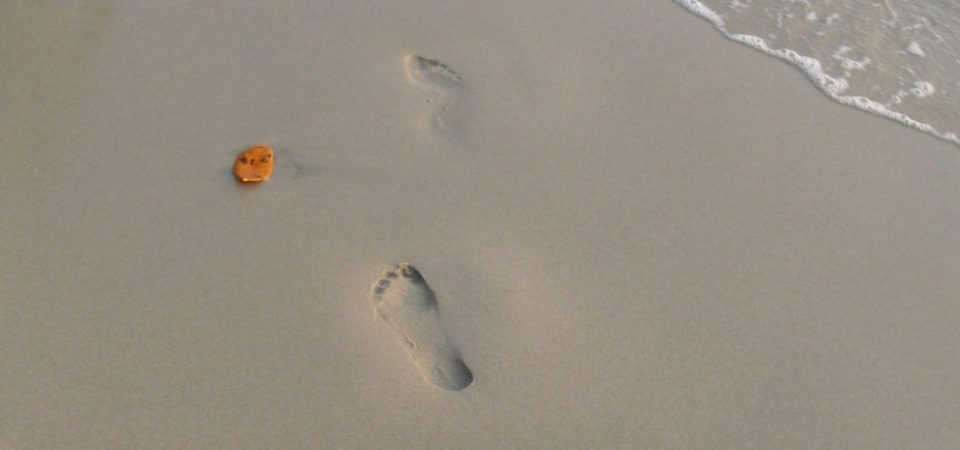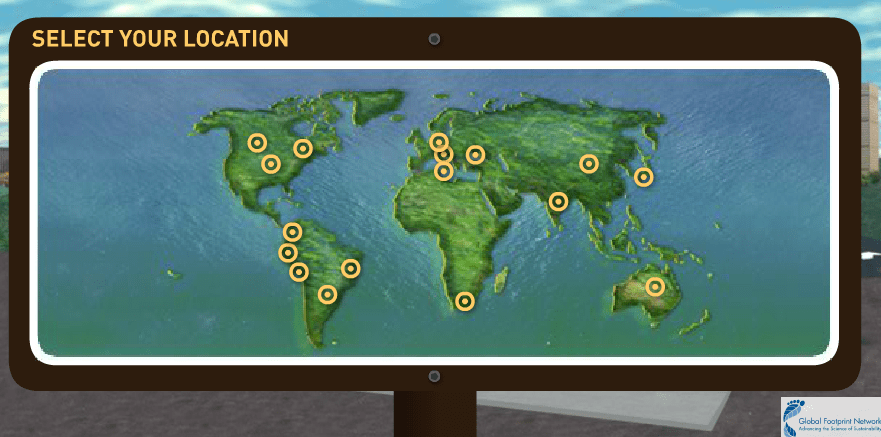Have you used the Global Footprint Network’s Calculator to estimate the amount of biologically productive area needed to support your lifestyle?
My curiosity was piqued by the video GFN released for its crowdfunding campaign to build a Footprint calculator mobile application. (The campaign ends December 5th, so definitely check it out!)
The Global Footprint Calculator provides an interactive way for you to answer questions about various aspects of your lifestyle that affect your Ecological Footprint. If you live in the United States individual-specific questions are asked about type of diet, local food, waste/recycling habits, electricity usage, type of house, personal transportation, public transportation, and airplane travel. For each topic, you have the option to give a quick, cruder, response or to use the calculator to give a more detailed evaluation. In the end, your responses to these lifestyle questions are combined with your nation’s societal burden from services such as health care or military operations. The Calculator presents the final output as the number of Earths that would be needed if everyone in the world lived like you. All 7.1 billion of us.
I have used the calculator in the past, but was interested in what had changed both in my own lifestyle and the calculator. If nothing else, I knew that the world population had increased since I last used the Calculator so any excess on my end was going to be amplified even more. So, preparing myself for a(nother) harsh reality check, I sat down to work out my Ecological Footprint.
I typically live in California during the academic year and spend the summer in Alaska. For many reasons, the differences in lifestyle go much farther than simple geography. Driven by curiosity, and the satisfaction of getting to compete with myself, I decided that I would go through the Calculator’s questions twice. First based on living in California and secondly based on living in Alaska.
California
A general description of life in California for me: I currently live with one other person in a condo located in a suburban area. Since this is coastal California I have yet to use heat or AC. Driving is usually limited to once or twice a week and typically occurs with at least one other person in the car. I prefer to buy local and fresh foods, and thankfully in California this is usually within my economic means. I rarely eat meat, but do eat fish and seafood from local sources. Finally, I admit to having a tremendous weak spot for dairy, especially cheese. This all got me to 3.8 Earths! This was sobering to say the least, especially when you keep in mind this specifically measures biologically productive space needed –not water, not fossil fuel supplies.
Thankfully, the Calculator does not leave you completely hanging. It provides options for reducing your footprint. It also allows you to return to questions to play around with different scenarios. Through the options the Calculator gave me, I was able to reduce my ‘score’ to 3.5 Earths. Still far from a great situation, but thinking about it as reducing the burden by 1/3 of the Earth helps keep things from feeling futile.
Alaska
Before I provide a general description of life let me clarify that this is based on summer in Alaska, not the colder, darker months when heating bills soar and locally grown foods become hard to find. In Alaska, I live in a two-story home with four to five other people. I do use a car more, probably twice per week but for short distances and usually with other people in the car. Vegetables and seafood are all local, but fruit and anything like pasta definitely have a high transport burden. In general, I eat more animal products while I am in Alaska. This time around my Ecological Footprint came out to 3.2 Earths needed if the entire world population lived like my Alaskan summers. With the optional commitments provided by the Calculator, I was again able to knock 0.3 Earths off my score getting me to 2.9 Earths.
Based on my self-competition, my Alaska summer lifestyle technically won out. But with 3.2 Earths worth of biologically productive area needed to support my lifestyle I was not comfortable taking a win on this one. I continued to run different scenarios of the Calculator, now competing not with myself but with the reality that more than 1 Earth simply does not work. I completed the questions as if I still lived in the log cabin I grew up in that had no running water or electricity, 2.9 Earths. I dressed my avatar in green and made all the most ‘sustainable’ lifestyle choices, 2.6 Earths.
It turns out I answered one of the most influential questions at the very beginning:
Selecting the United States locked me into a share of the biologically productive area needed to support the US’s infrastructure. As I altered my personal lifestyle, that share remained constant and high, a stark reminder that there are aspects of our Ecological Footprints that we must address indirectly. The GDN points out that personal, everyday choices need to be complemented with political engagement, investment in green technology and innovation, and work toward large-scale societal change.
Of course, there is also the other piece of the calculation. The scaling up to 7.1 billion people. Even if all aspects of my individual footprint remain constant, the numbers of Earths required to support the global population at that level will continue to rise with human population growth. Here, again, I can have an impact directly through my personal choices and also indirectly by working to shift social conventions and placing human population size in conversations about sustainability.
If you have not yet used the GFN Calculator to assess your Ecological Footprint, I strongly urge you to take a few minutes to run through the questions. Just get a rough idea of where you are at. Then think about how much more powerful this tool could be if it was easily accessible to more people. Think about if it could be used across the globe to bring attention to the current burden each one of us, and the collective 7.1 billion of us, place on our one Earth.
If the GFN Calculator is something you are willing and able to support, you can find out more about the campaign here. The campaign ends December 5th!
MAHB-UTS Blogs are a joint venture between the University of Technology Sydney and the Millennium Alliance for Humanity and the Biosphere. Questions should be directed to joan@mahbonline.org
MAHB Blog: https://mahb.stanford.edu/blog/footprint/
The views and opinions expressed through the MAHB Website are those of the contributing authors and do not necessarily reflect an official position of the MAHB. The MAHB aims to share a range of perspectives and welcomes the discussions that they prompt.

